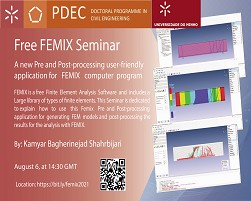FEMIX is based on the Finite Element Method (FEM), and includes a large library of types of finite elements (FE), which is complemented with a set of point, line and surface springs that model diverse contact conditions with the supports, and also several types of interface FE to model inter‑element contact. Embedded line FE can be added to other types of elements to model reinforcement bars. All these types of FE can be simultaneously included in the same analysis, with the exception of some incompatible combinations. The analysis may be static or dynamic, and the material and geometric behavior may be linear or nonlinear. In the same analysis several nonlinear models may be simultaneously considered.
Interface FE with appropriate friction laws and nonlinear springs may also be simultaneously considered. Time dependent phenomena like concrete maturation including creep and shrinkage can be also simulated, as well as fire with its influence on the degradation of the mechanical properties of concrete and steel reinforcements. The global response history is recorded in all the sampling points for post‑processing purposes. Advanced numerical techniques are available, such as the Newton‑Raphson method combined with arc‑length techniques and path dependent or independent algorithms. When the size of the systems of linear equations is very large, a preconditioned conjugate gradient method can be advantageously used.
Despite the post-processing can be performed with a general-purpose scientific visualization program named drawmesh, or using GID, recently a user-friendly application was developed. This Femix Pre- and Post-processing user-friendly application is an interface for drawing different parts of structural elements and uses the GMSH engine for different types of mesh generation. It can also generate Femix input data within visual and easy-to-use forms. This application has also internal post-processing tools for visualization of the Femix results such as displacements, stresses, strains, and crack patterns. In addition, different types of graphs like the Load-deflection curves for certain points can be drawn inside the application interface. Finally, the results could be exported to ParaView, which is an open-source, multi-platform data analysis and visualization application for further investigations.
This Seminar is dedicated to explain how to use this Femix Pre- and Post-processing application for generating FEM models and post-processing the results for the analysis with FEMIX.
Please click the link to join the seminar: https://videoconf-colibri.zoom.us/j/88220644630
